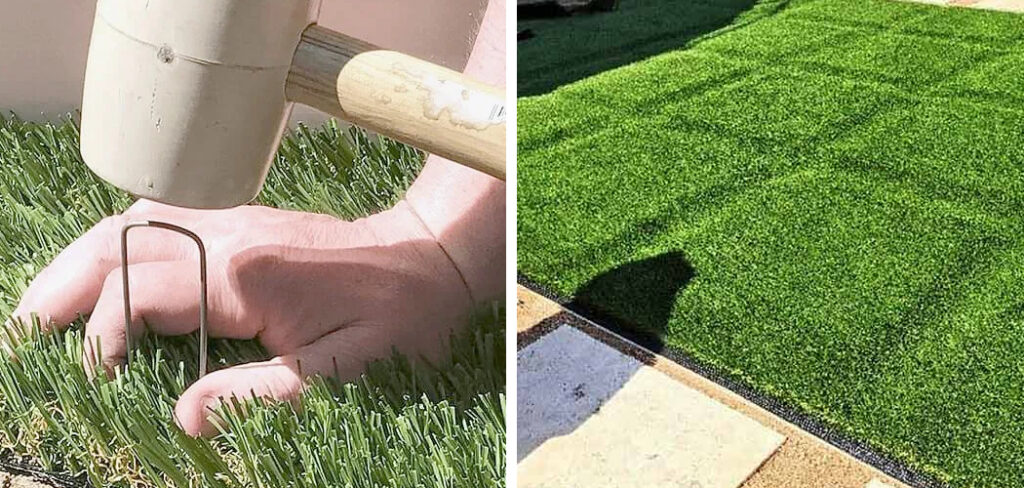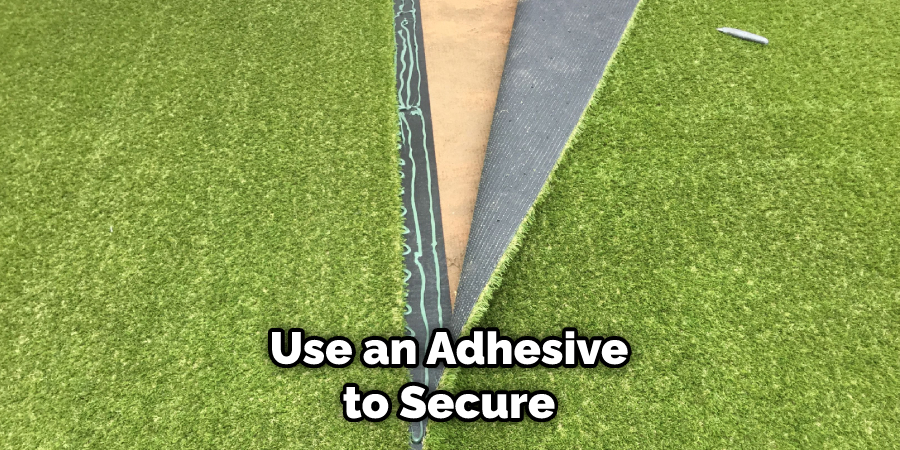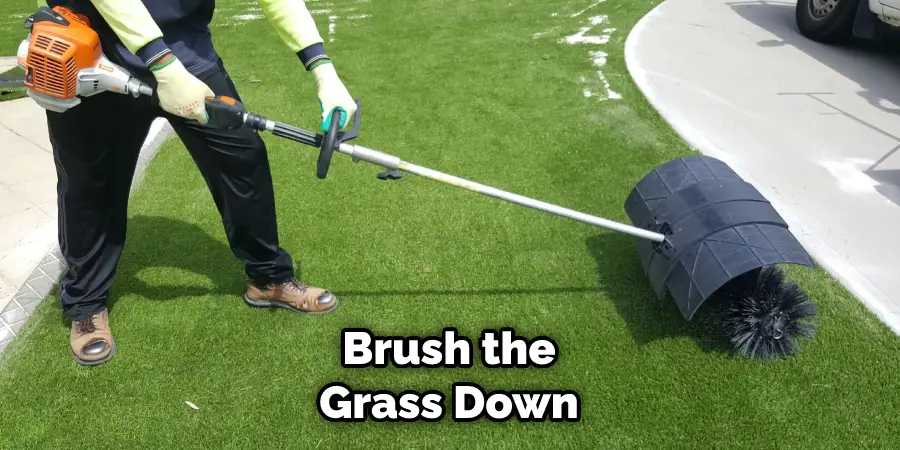Artificial grass looks and feels like real grass, but with the benefit of being very low maintenance. To really make sure that your artificial lawn is properly secured to the ground, you need to know how to secure it so it can withstand the elements and stay put in your garden.

Securing artificial grass to soil ensures that it will not move, shift, or become damaged over time. It also helps prevent growing weeds and keeps the grass neat and tidy.
Using artificial grass to soil is a great way of creating an attractive, low-maintenance lawn. Artificial grass requires only minimal watering and mowing, making it ideal for those who don’t have the time or resources for regular lawn maintenance.
But if you want your artificial grass to stay in place and look its best, it must be properly secured to the soil. You can find step-by-step instructions on how to secure artificial grass to soil in this blog article.
Tools You Will Need
- uGarden hose
- Weed barrier fabric
- Landscape pins
- Shovel
- Marking paint or string line
- Hammer
- Flathead shovel
- Artificial grass auto adhesive
- Wheelbarrow/utility cart
- Garden rake.
Step by Step Processes for How to Secure Artificial Grass to Soil
Step 1: Inspect the Soil

The first and most important step when securing artificial grass is to inspect the soil on which it will be laid. When inspecting the soil, check for any potential weeds or other items that could cause issues with the artificial grass. Additionally, ensure that the soil is level, so there are no bumps or dips in it.
Step 2: Add a Base Layer
It is important to add a base layer to provide a good foundation for artificial grass. This layer should be composed of compacted sand or aggregate, typically about two inches thick. Adding this layer, it will help to keep the artificial grass in place and prevent any shifting over time.
Step 3: Secure the Edges
Once the base layer has been installed, securing the edges of the artificial grass is important. This can be done by using pieces of landscape edging or something similar along the perimeter of the grass. The edging should be secured with nails or screws to help keep it in place and prevent any movement.
Step 4: Fill in Any Gaps
Once the edging is secure, use a trowel to fill in any spaces or gaps between the artificial grass and the edge. This will help to create a more solid foundation for the grass so it can be secured better onto the soil.
Step 5: Secure with Adhesive
Lastly, use an adhesive to secure the artificial grass to the soil. This will help to ensure that it stays in place and prevents any movement over time. Make sure to follow the manufacturer’s instructions while using the adhesive, as this will ensure proper application.

Once the adhesive has been applied, allow it to dry completely before using the grass.
Following these steps will help ensure that the artificial grass is properly secured onto the soil and will last many years.
Tips for How to Secure Artificial Grass to Soil
- Wear protective gear such as gloves, safety glasses, and a dust mask when securing artificial grass to the soil.
- Ensure the area is clear of any debris, stones, or twigs that might interfere with the installation process before starting.
- Measure the area where you want your artificial grass installed and ensure it is the correct size.
- Mark out the borders and lay down the base material – usually a weed membrane or a geotextile underlayment – to create an even surface for installation.
- Secure the artificial grass in place with nails, staples, or self-adhesive tape around the perimeter of the area.
- Brush the grass down with a stiff broom to ensure it’s fully secured and lies flat on the surface.
- Add additional fixing materials such as sand, stones, or wood chips to weigh down the grass and prevent any movement or rippling when people walk on it.
- For added safety, use an adhesive to glue any loose parts of the artificial grass to the base material for extra stability.

By following these easy steps, you’ll have a secure and safe installation of artificial grass on the soil.
How Do You Clean and Maintain the Artificial Grass After Installation?
After installation, properly caring for your artificial grass will help maintain its longevity. To begin cleaning and maintaining the turf, start by using a stiff brush to remove any dirt or debris that has settled on the surface. If there are any stubborn spots or difficult stains, use a mild soap and water solution to scrub them away.
When washing, it’s important to be gentle with the artificial grass, so you don’t damage its fibers. After scrubbing, make sure to rinse off any soap residue with clean water.
Once dry, use a rake or broom to brush the grass in an upward direction and help the turf stand upright again. For regular maintenance, it’s important to check for any loose sections or seams that may have come undone during use.
If needed, you can secure them back down with a strong adhesive. You should also consider having the artificial grass professionally cleaned at least once a year by an experienced technician in order to ensure its longevity and beauty. By following these tips, you can help keep your artificial grass in top shape and ensure it looks great for years to come.
How Can You Make Sure That Your Artificial Grass Lasts for a Long Time?
When installing artificial grass, it is important to ensure that the grass is securely fastened in place. This will help ensure that the turf stays in place and lasts for a long time. There are a few ways to secure your artificial grass to the soil, including using staples or special adhesives.
Staples are generally used as the primary method of securing artificial grass to the soil. This is because staples are easy to install and remove and provide a strong connection between the turf and the ground. It is important that you use heavy-duty staples which are specifically designed for this purpose.

After installing the turf, secure it with a staple gun every 12 inches along all edges and then every 4-6 inches in the center. In addition to staples, some people also use special adhesives to secure artificial grass to the soil. These adhesives can provide an even stronger bond than staples but are more difficult to install.
It is important to follow instructions carefully when applying the adhesive so that it is secure.
Are There Any Special Considerations When Installing Synthetic Turf Over Existing Soil or Concrete?
When installing artificial grass over existing soil or concrete, a few special considerations need to be taken into account. Firstly, the surface should be clean and free of debris so that it is ready for installation. If necessary, use a pressure washer to remove any dirt and debris from the surface before you begin.
Secondly, you may need to lay a retardant weed sheet or foam pad over the area before installing the artificial grass. This will help prevent weeds from growing up through the turf and help ensure that it remains secure.
Thirdly, you should use special adhesive tape to secure the edges of the turf together and around any hard edges such as steps, flowerbeds, etc. This will help keep it in place and prevent it from moving or shifting once installed.
Finally, you should use turf nails to secure the artificial grass to the soil. The nails should be inserted at regular intervals along the perimeter of the area, spaced approximately 10-15 cm apart. This will help to keep the turf in place and prevent it from being lifted or moved by wind or other environmental conditions.
Conclusion
One of the biggest disadvantages of securing artificial grass to soil is that it can be difficult and time-consuming. It requires digging a trench around the area’s perimeter, then carefully measuring out sand or other base material to ensure an even layer before laying down the grass.
You must also join together any seams between pieces of artificial grass and secure them to the ground with nails, staples or pegs. Additionally, artificial grass can also be vulnerable to strong winds, so extra care must be taken when installing it outdoors.
In conclusion, securing artificial grass to soil is a straightforward process. You can achieve this by using nails, sand infill, and turf adhesive. Nails help keep the grass in place, while sand infill adds extra security and traction for use.
Turf adhesive provides a strong bond when used on larger sections of artificial grass. It’s important to ensure you have all the necessary supplies and take safety measures when following this procedure. I hope this article has been beneficial for learning how to secure artificial grass to soil. Make Sure the precautionary measures are followed chronologically.
About
Outdoor Fixes is a distinguished figure in the world of Diy design, with a decade of expertise creating innovative and sustainable Diy solutions.
His professional focus lies in merging traditional craftsmanship with modern manufacturing techniques,
fostering designs that are both practical and environmentally conscious. As the author of diy,
outdoorfixes delves into the art and science of outdoorfixes-making, inspiring artisans and industry professionals alike.
Education RMIT University
(Melbourne, Australia) Associate Degree in Design (Outdoor Fixes) Focus on sustainable design, industry-driven projects,
and practical craftsmanship. Gained hands-on experience with traditional and digital manufacturing tools, such as CAD and CNC software.
Nottingham Trent University
(United Kingdom) Bachelor’s in outdoorfixes.com and Product Design (Honors) Specialized in product design with a focus on blending creativity with production
techniques. Participated in industry projects, working with companies like John Lewis and Vitsoe to gain real-world insights.
Publications and Impact
In diy, Outdoor Fixes his insights on indoor design processes, materials, and strategies for efficient production.
His writing bridges the gap between artisan knowledge and modern industry needs, making it a must-read for both budding designers and seasoned professionals.

